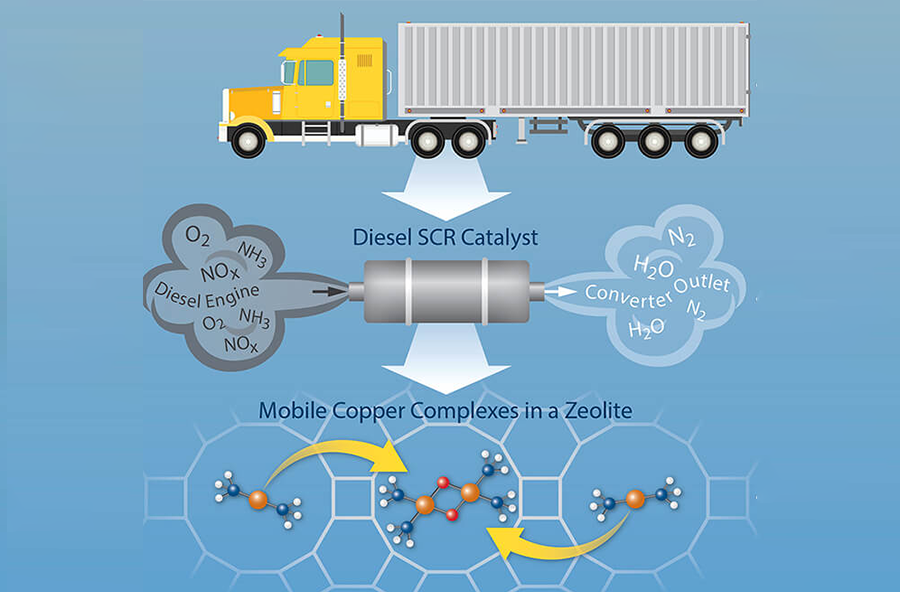Researchers Discover Improved Copper-Zeolite Catalyst Designs for Selective Catalytic Reduction (SCR) of Nitrogen Oxides (NOx) in Diesel Exhaust

This diagram depicts a new reaction mechanism that could be used to improve catalyst designs for pollution-control systems for diesel exhaust. (Purdue University photo/Mo Lifton)
This discovery will help improve the design of catalysts to further reduce diesel exhaust related emissions of smog-causing nitrogen oxides (NOx). Published in the March 2023 issue of Nature Catalysis, the study focuses on zeolites, catalysts used in petroleum and chemical refineries and in emission-control systems for diesel engines. This research, funded by the National Science Foundation’s (NSF) Designing Materials to Revolutionize and Engineer our Future (DMREF) program, represents a breakthrough in the design of more efficient zeolite catalysts.

Dr. Rajamani Gounder, Purdue’s Larry and Virginia Faith Assistant Professor of Chemical Engineering, led the research for improved zeolite catalyst designs.
This newest discovery came from a team of researchers led by Prof. Rajamani Gounder, the Larry and Virginia Faith Professor in the Davidson School of Chemical Engineering at Purdue University. This study is a follow-up to an article published by this team in a 2017 edition of the journal Science, describing innovative research of copper-zeolite catalysts used to remove NOx compounds from diesel exhaust. While current catalyst designs work well, as vehicles become more efficient and operate at lower temperatures, better performing catalysts are needed. In 2017, this research team found that NOx reduction on copper-zeolites involves the dynamic pairing of two copper sites to activate dioxygen molecules, and that the mobility of these copper sites is dependent on their interactions with specific binding sites (Al) in the zeolite host lattice. In this newest study, the team found that increasing the density of the zeolite lattice AI sites is able to significantly accelerate reaction rates, providing a strategy to design more efficient copper-zeolite catalysts for NOx reduction.
The lead researcher on this study, Dr. Siddarth Krishna, was previously a Henson Postdoctoral Fellow in the Davidson School of Chemical Engineering at Purdue University. He received the inaugural Outstanding Postdoc Award from Purdue's College of Engineering in 2021 and is now the Duane and Dorothy Bluemke Assistant Professor in the Department of Chemical and Biological Engineering at the University of Wisconsin-Madison.

Dr. Siddarth Krishna, University of Wisconsin-Madison’s Duane and Dorthy Bluemke Assistant Professor, co-led a team of researchers in the discovery of improved zeolite catalyst designs.
In addition to Krishna and Gounder, the paper was authored by Purdue graduate students Casey B. Jones and David P. Dean, University of Notre Dame graduate students Anshuman Goswami and Yujia Wang, Purdue professor of chemical engineering Jeffrey T. Miller, and University of Notre Dame Dorini Family Chair of Energy Studies and Concurrent Professor William F. Schneider.
Read the full Nature Catalysis article: https://www.nature.com/articles/s41929-023-00932-5
Source: Dr. Rajamani Gounder, rgounder@purdue.edu
Writer: Jessica Johnson, john1690@purdue.edu
